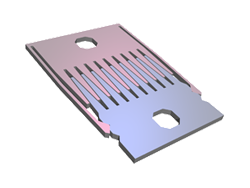Biological Microfabrication
The tools for constructing microelectronic integrated circuits can be adapted to control the spatial arrangement of cultured mammalian cells, allowing us to mimic the precise structure of living tissue. By contriving appropriate patterns, specific biological variables can be isolated to gain understanding of cellular mechanisms. Engineered tissue is also constructed for use as organ models and perhaps even organ replacement. Microstructured materials and devices are also appropriate for supporting and manipulating explanted organoids and microscopic animals.
Reconfigurable Culture
Living tissue is a dynamic and structurally complex system that is poorly replicated in conventional laboratory culture. We are developing microdevices that can dynamically reorganize cultured tissue at the scale of individual cells, allowing natural processes to be better mimicked and studied. Systems that involve multiple interacting cell populations are most suitable to our platforms. Our current interlocking comb system (see sidebar) allows manipulation of 2D cultures and has successfully been adapted to numerous biological systems in various laboratories. We look forward to discussing whether our current or future tools are applicable to your biological system of interest.
Microfluidic Computing
Microfluidics has enabled the automated execution of numerous multiplexed chemical reactions on a small microchip. However, significant off-chip resources are typically required, including pumps, pneumatic manifolds, and digital controllers. Integrating these elements onto the chip itself could bring tremendous gains in manufacturing cost, reliability, ease of use, and portability. We are approaching this problem by dispensing with electronic control, and instead building digital logic systems out of microfluidic gates themselves.


